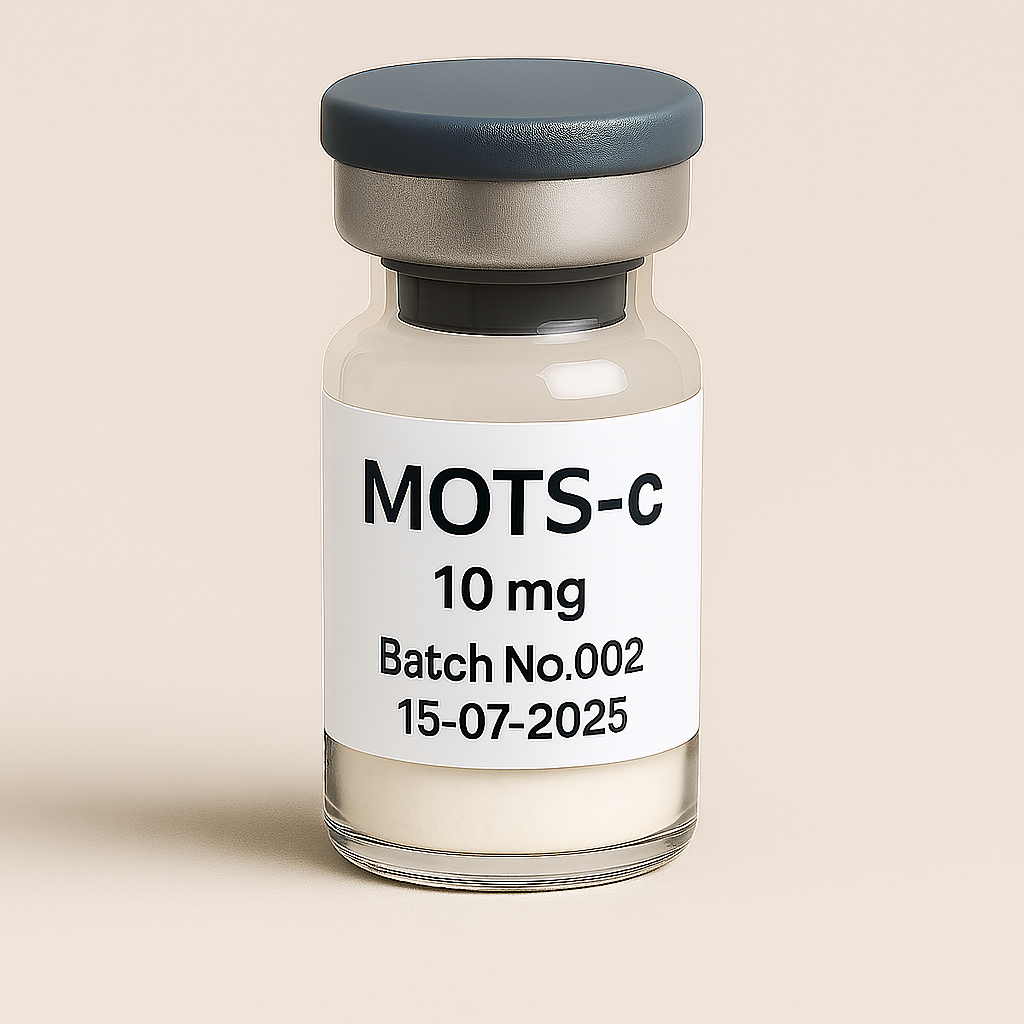A
Anonymous Ok
J
Johanna Larsson Great quality 🤩

MOTS-c 10mg vial
Pickup currently not available
NOT FOR HUMAN CONSUMPTION
MOTS-c is a recently discovered mitochondrial-derived peptide encoded by mitochondrial DNA. Identified in 2015, MOTS-c plays a significant role in regulating metabolism, energy homeostasis, mitochondrial function, insulin sensitivity, and potentially longevity. Due to its unique mitochondrial origin and metabolic-regulatory properties, MOTS-c has attracted interest as a potential therapeutic agent in metabolic and aging-related disorders.
Full Name: Mitochondrial Open Reading Frame of the Twelve S rRNA type-c
Structure: Small peptide (16 amino acids: MRWQEMGYIFYPRKLR)
Origin: Encoded by mitochondrial DNA, synthesized and released into the cytoplasm and systemic circulation
Administration Routes: Typically administered via subcutaneous injection in experimental studies due to peptide stability and bioavailability considerations
MOTS-c acts primarily through metabolic modulation and mitochondrial regulation:
Activates the AMPK (AMP-activated protein kinase) pathway, a critical regulator of energy homeostasis, glucose metabolism, and fatty acid oxidation.
Improves insulin sensitivity, glucose uptake, and overall metabolic health.
Increases mitochondrial biogenesis and efficiency, enhancing cellular energy production.
May protect against metabolic disorders and aging-related declines in mitochondrial function.
Reduces inflammation and oxidative stress, potentially protecting tissues from chronic metabolic stress.
MOTS-c mimics some beneficial effects of exercise, potentially improving endurance, performance, and metabolic health without physical activity.
MOTS-c has shown promising potential in several preclinical and experimental contexts:
Demonstrates significant improvements in glucose regulation and insulin sensitivity, potentially beneficial for managing type 2 diabetes and metabolic syndrome.
Enhances fatty acid oxidation, energy expenditure, and metabolism, potentially aiding in weight loss or obesity prevention.
Proposed as a novel longevity-promoting compound due to mitochondrial protection, improved metabolism, and reduced inflammation.
May prevent age-related metabolic dysfunction, sarcopenia (muscle wasting), and cognitive decline.
Potentially beneficial for cardiovascular disease prevention due to anti-inflammatory, metabolic, and antioxidant properties.
Preclinical studies suggest MOTS-c enhances physical endurance, exercise performance, and muscular efficiency, leading to interest as a performance-enhancing compound.
No established clinical dosage guidelines exist due to limited human studies. Typical experimental dosages based on preclinical studies and anecdotal reports are:
Dosage Range: 5–15 mg per administration (common experimental doses: 5–10 mg weekly).
Route of Administration: Subcutaneous injection, typically once weekly.
Experimental Cycle Length: Usually administered experimentally over 4–8 weeks, followed by an evaluation period.
Note: The above dosages are experimental and not clinically validated; human equivalent dosages require rigorous clinical research.
Due to the limited clinical human trials, full safety profiles remain preliminary; however, preclinical studies suggest favorable tolerability:
Mild injection-site discomfort, redness, or swelling.
Transient dizziness, mild fatigue, or headaches (rarely reported).
Insufficient long-term safety data available.
No reported evidence of dependency, addiction, or withdrawal symptoms in existing studies.
Contraindications:
Pregnancy and breastfeeding (unknown safety profile).
Known hypersensitivity to peptide-based compounds.
Drug Interactions:
Limited known drug interactions; caution advised when used concurrently with insulin, oral hypoglycemics, or other metabolic modulators.
Precautions:
Patients with severe metabolic disorders or insulin-dependent diabetes should consult healthcare professionals due to MOTS-c’s potent metabolic effects.
Approval and Regulation: MOTS-c is currently not approved by major regulatory agencies (FDA, EMA, Health Canada) for therapeutic human use.
Typically available as a "research peptide" or experimental compound labeled as "not for human consumption."
Not explicitly banned by WADA; athletes should confirm updated regulations before competitive use.
Preclinical Research:
Numerous animal studies demonstrate significant metabolic improvements, endurance enhancement, longevity-related effects, and mitochondrial protective benefits.
Human Clinical Trials:
Very limited, with initial exploratory studies ongoing or in planning stages.
Preliminary small-scale observational studies and anecdotal evidence suggest metabolic benefits and improved exercise tolerance, though larger controlled trials are necessary.
Research Limitations and Future Directions:
Lack of extensive human clinical data and randomized controlled trials (RCTs).
Need for standardized dosing, long-term safety evaluation, and clearly defined clinical efficacy.
| Potential Benefits | Potential Risks and Limitations |
|---|---|
| Improved insulin sensitivity and metabolic health | Limited human clinical data |
| Potential longevity and anti-aging effects | Unclear long-term safety profile |
| Enhanced exercise performance and endurance | Possible interactions with metabolic medications |
| Anti-inflammatory and mitochondrial protective effects | Regulatory uncertainty; experimental availability |
Conduct rigorous human clinical trials to establish efficacy, safety, optimal dosing, and therapeutic potential.
Long-term studies needed to evaluate potential chronic effects, safety, and effectiveness in various populations.
Exploration of MOTS-c’s therapeutic potential in metabolic diseases, aging, cardiovascular diseases, and physical performance enhancement.
MOTS-c is a promising mitochondrial-derived peptide with demonstrated metabolic, mitochondrial, and potential anti-aging benefits. Preclinical research strongly supports its potential role in managing metabolic disorders, promoting healthy aging, and enhancing exercise performance. However, significant gaps in clinical research, dosing standardization, and long-term safety evaluations remain. Until comprehensive human studies confirm safety and efficacy, MOTS-c remains a novel experimental compound with substantial therapeutic promise.
Lee, C., et al. (2015). "The mitochondrial-derived peptide MOTS-c promotes metabolic homeostasis and reduces obesity and insulin resistance." Cell Metabolism, 21(3), 443–454.
Kim, K. H., & Son, J. M. (2019). "Mitochondrial peptides as promising targets for age-related metabolic disorders." Experimental Gerontology, 121, 15–19.
Reynolds, J. C., et al. (2021). "MOTS-c is an exercise-induced mitochondrial-encoded regulator of age-dependent physical decline and muscle homeostasis." Nature Communications, 12(1), 470.
Disclaimer:
This product is provided exclusively for educational purposes. MOTS-c is an experimental research compound and has not been approved by major health regulatory authorities for clinical therapeutic use. Always consult qualified healthcare providers before considering experimental peptides or supplements.